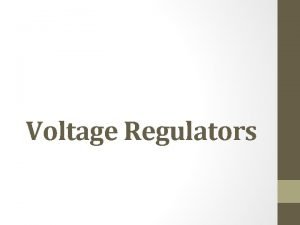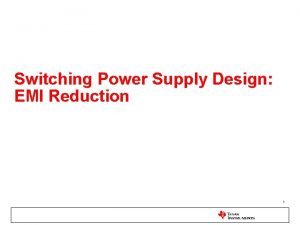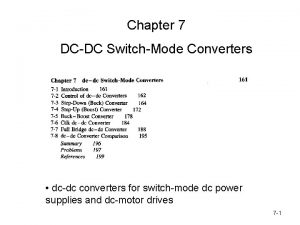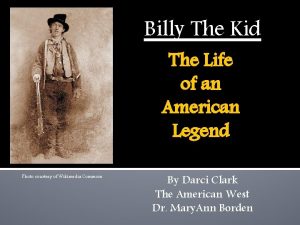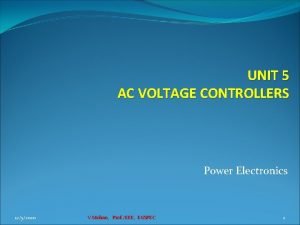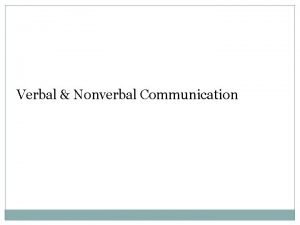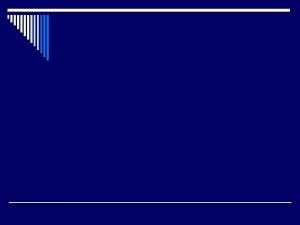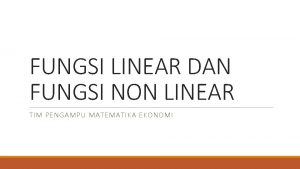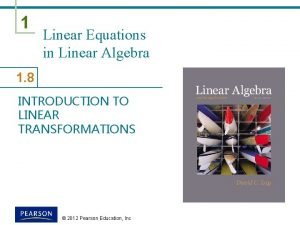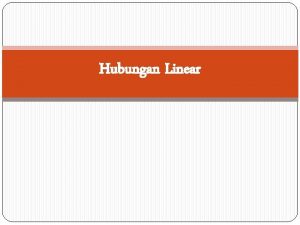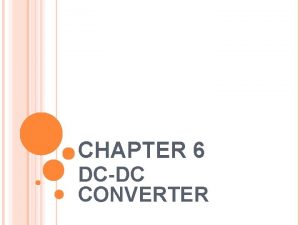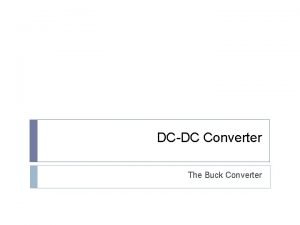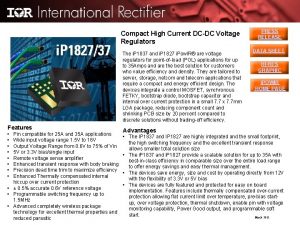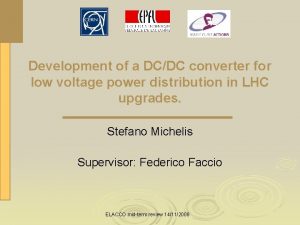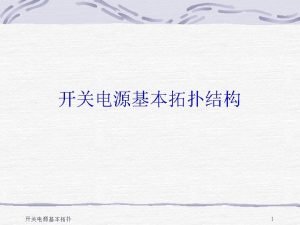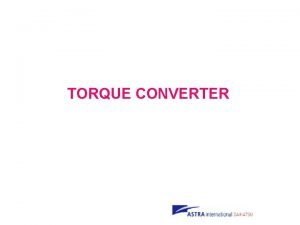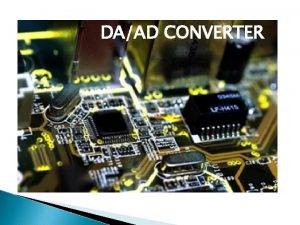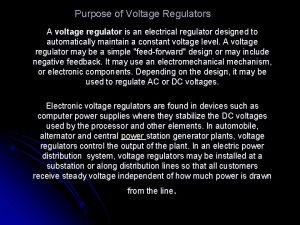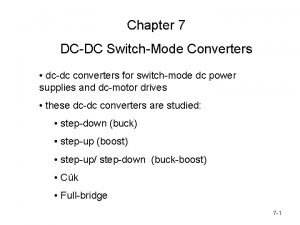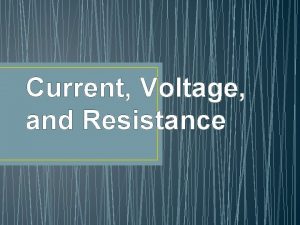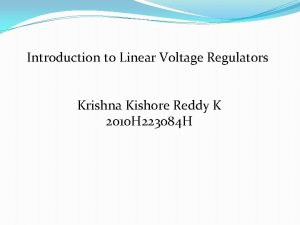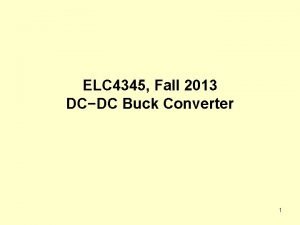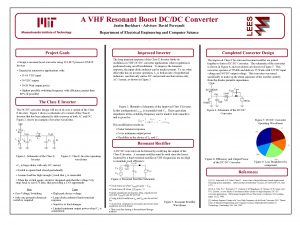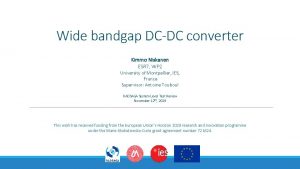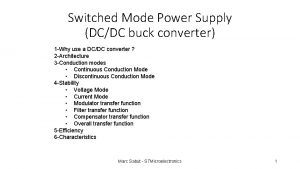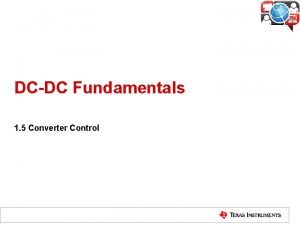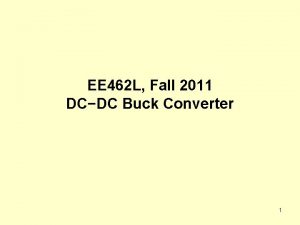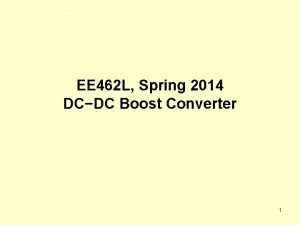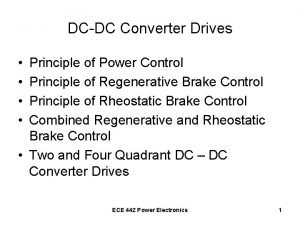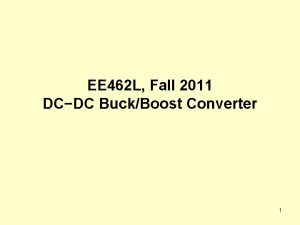CHAPTER 6 DCDC CONVERTER 1 LINEAR VOLTAGE REGULATORS





























- Slides: 29

CHAPTER 6 DC-DC CONVERTER

1) LINEAR VOLTAGE REGULATORS The voltage output is

Load current is controlled by the transistor. By adjusting the transistor base current, the output voltage may be controlled over a range of 0 to Vo roughly. The base current can be adjusted to compensate for variations in the supply voltage or the load, thus regulating the output. This type of circuit is called a linear DC/DC converter or a linear regulator because the transistor operates in the linear region, rather than in the saturation or cutoff region. The transistor, in effect, operates as a variable resistance. The power loss in the transistor makes this circuit inefficient. The power absorbed by the load is Vo. IL, and the power absorbed by the transistor is VCEIL assuming a small base current.

2) BASIC SWITCHING CONVERTER also known as a dc chopper switching con verter circuit, the transistor operates as an electronic switch by being completely on or com pletely off (saturation or cutoff for a BJT) the output is the same as the input when the switch is closed, and the output is zero when the switch is open

Output voltage: Duty ratio D: Power absorbed by the ideal switch is zero. Switch open: there is no current in it Switch closed: there is no voltage across it. All power is absorbed by the load, and the energy efficiency is 100%. Losses will occur in a real switch because the voltage across it will not be zero when it is on, and the switch must pass through the linear region when making a transition from one state to the other.

3) DC/DC BUCK CONVERTER Step down converter: the output voltage is less than the input. Analysis of the buck converter: (assumptions) i. The circuit is operating in the steady state. ii. The inductor current is continuous (always positive). iii. The capacitor is very large, and the output voltage is held constant at voltage Vo. This restriction will be relaxed later to show the effects of finite capacitance. iv. The switching period is T; the switch is closed for time DT and open for time (1 D)T. v. The components are ideal.

I. ANALYSIS FOR THE SWITCH; Switch Closed Switch Open

II. STEADY STATE OPERATION: Inductor current at the end of the switching cycle be the same as that at the beginning (the net change in inductor current over one period is zero). The buck converter produces an output which is less than or equal to the input. the output voltage depends only on the input and the duty ratio D.

III. INDUCTOR CURRENT IS CONTINUOUS: The average inductor current must be the same as the average current in the load resistor, since the average capacitor current must be zero for steady state operation: The maximum and minimum values of the inductor current are computed as: the minimum value of inductor current must be positive for continuous current.

the minimum inductance required for continuous current; For Continuous Current:

IV. OUTPUT VOLTAGE RIPPLE The variation in output voltage ripple is computed from the voltage current relationship of the capacitor. Capacitor current is positive, the capacitor is charging. is the peak to peak ripple voltage at the output.

V. COMPONENTS ARE IDEAL the power supplied by the source must be the same as the power absorbed by the load resistor

EXAMPLE 1; The buck dc dc converter has the following parameters: Assuming ideal components, calculate (a) the output voltage Vo, (b) the maximum and minimum inductor current, and (c) the output voltage ripple.

4) DC/DC BOOST CONVERTER Step up converter: the output voltage is larger than the input Analysis of the boost converter: (assumptions) 1. Steady state condition exists. 2. The switching period is T; the switch is closed for DT time and open for time (1 D)T. 3. The inductor current is continuous (always positive). 4. The capacitor is very large, and the output voltage is held constant at voltage Vo. 5. The components are ideal.

I. ANALYSIS FOR THE SWITCH; Switch Closed Switch Open

II. STEADY STATE OPERATION: The rate of change of inductor current is constant, so the current must change linearly while the switch is open. The boost converter produces an output voltage that is greater than or equal to the input voltage.

III. INDUCTOR CURRENT IS CONTINUOUS: The average current in the inductor is determined by recognizing that the power supplied by the source must be the same as the power absorbed by the load resistor. The maximum and minimum values of the inductor current are computed as:

the minimum inductance required for continuous current; For Continuous Current:

IV. OUTPUT VOLTAGE RIPPLE The change in capacitor charge Expression for ripple ;

V. COMPONENTS ARE IDEAL power supplied by the source must be the same as the power absorbed by the load resistor

EXAMPLE 2; The boost converter has the following parameters: Assuming ideal components, calculate (a) the output voltage Vo, (b) the maximum and minimum inductor current, and (c) the output voltage ripple.

5) DC/DC BUCK-BOOST CONVERTER The output of the buck boost converter can be either higher or lower than the input voltage. Analysis of the buck boost converter: (assumptions) 1. The circuit is operating in steady state. 2. The inductor current is continuous (always positive). 3. The capacitor is very large, and the output voltage is held constant at voltage Vo 4. The switch is closed for time DT and open for time (1 -D)T. 5. The components are ideal.

I. ANALYSIS FOR THE SWITCH; Switch Closed Switch Open

II. STEADY STATE OPERATION: For steady state operation, the net change in the inductor current must be zero over one period. Output magnitude of the buck-boost converter can be less than the source or greater than the source, depending on the duty ratio of the switch. D > 0. 5 , the output is larger than the input D< 0. 5 , the output is smaller than the input

III. INDUCTOR CURRENT IS CONTINUOUS: Average source current is related to average inductor current The maximum and minimum values of the inductor current are computed as:

the minimum inductance required for continuous current; For Continuous Current:

IV. OUTPUT VOLTAGE RIPPLE The output voltage ripple for the buck boost converter is computed from the capacitor current waveform Expression for ripple ;

V. COMPONENTS ARE IDEAL Power absorbed by the load must be the same as that supplied by the source;

EXAMPLE 3; The buck boost circuit has these parameters: Determine the : 1. Output voltage, 2. Inductor current, and 3. Output ripple.
 Cbi detroit
Cbi detroit Shunt type voltage regulator
Shunt type voltage regulator Buck converter and boost converter
Buck converter and boost converter Switch mode converter
Switch mode converter Buck converter output voltage
Buck converter output voltage Voltage classification
Voltage classification Ac voltage controller output voltage formula
Ac voltage controller output voltage formula Line current and phase current
Line current and phase current Voltage peak to peak to rms
Voltage peak to peak to rms What is the objective of earthing
What is the objective of earthing Regulators apush
Regulators apush Doc scurlock
Doc scurlock North american gaming regulators association
North american gaming regulators association Ac regulators in power electronics
Ac regulators in power electronics Occulistics
Occulistics Prandial glucose regulators
Prandial glucose regulators Simple and multiple linear regression
Simple and multiple linear regression Contoh soal biseksi
Contoh soal biseksi Linear text and non linear text
Linear text and non linear text Nonlinear narrative definition
Nonlinear narrative definition Metode newton raphson
Metode newton raphson Non linear pipeline
Non linear pipeline A multimedia project is identified as non-linear when
A multimedia project is identified as non-linear when Convert right linear grammar to left linear grammar
Convert right linear grammar to left linear grammar Fungsi linear dan non linear matematika ekonomi
Fungsi linear dan non linear matematika ekonomi Jelaskan
Jelaskan Conditions for linear independence
Conditions for linear independence Linear algebra 1
Linear algebra 1 Cara koordinat lereng
Cara koordinat lereng How to find maximum compression of a spring formula
How to find maximum compression of a spring formula

